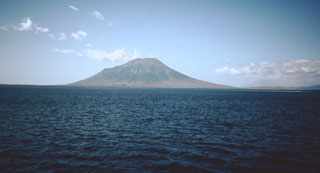Report on Lewotolok (Indonesia) — 2 July-8 July 2025
Smithsonian Institution / US Geological Survey
Weekly Volcanic Activity Report, 2 July-8 July 2025
Managing Editor: Sally Sennert.
Please cite this report as:
Global Volcanism Program, 2025. Report on Lewotolok (Indonesia) (Sennert, S, ed.). Weekly Volcanic Activity Report, 2 July-8 July 2025. Smithsonian Institution and US Geological Survey.
Lewotolok
Indonesia
8.274°S, 123.508°E; summit elev. 1431 m
All times are local (unless otherwise noted)
The Pusat Vulkanologi dan Mitigasi Bencana Geologi (PVMBG) reported that the eruption at Lewotolok intensified during 27 June-2 July, with activity that included taller white, gray, and black ash plumes that rose 1.2 km above the summit. Incandescent material was ejected in all directions, as far as 1.5 km N and ENE, and caused vegetation fires on the N and NE flanks. Rumbling and booming sounds were reported. At 2000 on 2 July the Alert Level as raised to 3 (on a scale of 1-4) and the public was warned to stay 3 km away from the summit. Daily gray, white-to-gray, or gray-to-black ash plumes rose 400-700 m above the summit of the cone and drifted NW, W, and SW during 2-8 July. Clear nighttime webcam images showed incandescent material both at the summit cone and being ejected above the cone. Lava flows on the flanks of the main volcano edifice were also incandescent.
Geological Summary. The Lewotolok (or Lewotolo) stratovolcano occupies the eastern end of an elongated peninsula extending north into the Flores Sea, connected to Lembata (formerly Lomblen) Island by a narrow isthmus. It is symmetrical when viewed from the north and east. A small cone with a 130-m-wide crater constructed at the SE side of a larger crater forms the volcano's high point. Many lava flows have reached the coastline. Eruptions recorded since 1660 have consisted of explosive activity from the summit crater.
Source: Pusat Vulkanologi dan Mitigasi Bencana Geologi (PVMBG, also known as CVGHM)

